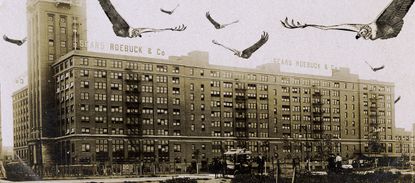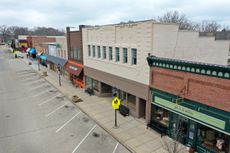How vulture capitalists ate Sears
Sears' business model and brand were from a bygone era. But the hedge-fund pillagers running the show never gave the company a chance to survive.


Sears, the iconic American retailer, filed for Chapter 11 bankruptcy on Monday. Many analysts are treating Sears' fall as a cautionary tale about imprudent borrowing and failures to adapt — particularly in the face of e-commerce and rivals like Amazon. There is obviously a lot of truth in this.
But there's another piece of the narrative that deserves just as much attention: how Sears was stripped for parts by a Wall Street hedge fund.
If you track the long-term course of Sears' revenue and stock price, the problems didn't just set in with the arrival of Walmart and the big-box stores, or with Amazon and the rise of the internet economy. Instead, the tailspin really started with the arrival of a guy named Eddie Lampert and his hedge fund, ESL Investments.
Subscribe to The Week
Escape your echo chamber. Get the facts behind the news, plus analysis from multiple perspectives.

Sign up for The Week's Free Newsletters
From our morning news briefing to a weekly Good News Newsletter, get the best of The Week delivered directly to your inbox.
From our morning news briefing to a weekly Good News Newsletter, get the best of The Week delivered directly to your inbox.
Lampert had already bought Kmart out of bankruptcy in 2003. And in 2004 and 2005, he engineered Kmart's purchase of and merger with Sears, creating the third-largest retailer in the country at the time. Lampert became chairman of the combined company's board. In 2013, Lampert became Sears' CEO.
Lampert slashed capital investments to try and create a more efficient company. He retooled Sears' structure, so that almost three dozen different business departments — like shoes, home furnishings, or menswear — were each siloed, with their own management team and even their own board. It was a model taken from the hedge fund world, meant to encourage healthy competition inside the company and thus power a better overall business.
"There are a lot of decisions made over a long period of time, including by me, that may not have been always the best decisions," Lampert told Vanity Fair in April. "But I did have a point of view in terms of how shopping habits were going to change." He didn't think Sears could ever compete on the same level with the likes of Bloomingdale's or Nordstrom, and shouldn't have spent money trying. "I don't need to invest in fixtures, but I do need to invest in the features and the experiences," he continued.
But critics contend Lampert really didn't know what he was doing.
Sears invested less than 1 percent of revenue in its own capital needs from 2006 to 2017, compared to 4 percent by Target and Macy's. Many Sears stores were left in rundown shape. And without attractive in-store experiences, the company couldn't springboard customers to its website. Meanwhile, the idea of siloing different departments into competing mini-companies may have worked in finance, where teams are just competing to create investment portfolios. But within the concrete goods-and-services world of Sears, it created a "lord of the flies" atmosphere where sales staff in the same store would refuse to help one another, or fight over ad and shelving space.
Now, one thing Lampert and ESL were able to engineer, at least for a while, was a massive return to shareholders — and Lampert owns nearly a third of all those shares himself. (ESL Investments owns another 19 percent.) Sears' profits boomed after the merger, before finally starting to fall around the time Lampert became CEO. The company plowed $6 billion into stock buybacks from 2005 to 2012, temporarily goosing the company's stock price.
Another thing Lampert and ESL did was load Sears up with debt. The company owes $5.6 billion. A lot of that credit was loaned to Sears by Lampert and his various operations. ESL Investments owns 40 percent of Sears' debt load all by itself. Lampert and his fellow hedge funders not only ran the company, and thus made the decision to borrow the money; they lent it the money, and thus benefit from Sears' debt service payments.
Finally, Lampert also had Sears sell off $3 billion of its physical properties in 2015 to a fund called Seritage Growth Properties. Lampert was chairman of Seritage's board of trustees. Sears went from owning its storefronts outright to often having to pay rent to stay in them — rent that, once again, Lampert benefited from.
This is not the way to operate a healthy business. This is the way to extract value. This is a story of corporate spinoffs and financial engineering to suck money out of Sears and into the pockets of Lampert and his fellows. The whole thing bears a striking resemblance to how Bain Capital and other private equity funds cannibalized Toys 'R' Us.
Obviously Sears had other problems beyond Lampert and this type of financial pillaging. Sears' business model and brand are of a bygone era, and it's arguable that nothing could have saved Sears. But Sears' fall is also a lesson in how the people at the top of a corporation can also act as a kind of modern-day viking raiding party, traveling from company to company and pillaging each in turn. "[Lampert] had a puppet board who have never pushed back in any way that anybody has ever seen, and why would they?" Mark Cohen, the former CEO of Sears Canada, told Vanity Fair. "They're all handpicked Eddie acolytes."
None of this is sustainable, of course. You can only bleed a company so much before it dies.
Sales and revenue eventually plummeted, and Sears hasn't turned a profit since 2010. It's closed over 2,000 stores since 2011. Over the last 10 years, the company's market value fell by at least $26 billion, and 175,000 of its employees lost their jobs. The workers and salespeople who remain have seen their take-home pay severely reduced over the last few years. Finally, bogged down by debt obligations, Sears filed for Chapter 11 on Monday.
The bankruptcy will involve closing another 142 unprofitable stores, on top of 46 other closings already in the works, leaving the company with probably around 600 stores remaining. The hope is that going through Chapter 11 will allow Sears to emerge on the other side still intact in some way.
As major holders of Sears' debt — debt that is largely secured, moreover — Lampert and ESL will have enormous sway over how the bankruptcy proceeds. Chapter 11 will either repay the debt they're owed, or transform their debt holdings into new shareholder positions
They ran Sears into the ground, and yes, they'll lose a bunch of money for that. But they'll make a bunch of money, too.
Create an account with the same email registered to your subscription to unlock access.
Sign up for Today's Best Articles in your inbox
A free daily email with the biggest news stories of the day – and the best features from TheWeek.com
Jeff Spross was the economics and business correspondent at TheWeek.com. He was previously a reporter at ThinkProgress.
-
 Do youth curfews work?
Do youth curfews work?Today's big question Banning unaccompanied children from towns and cities is popular with some voters but is contentious politically
By Harriet Marsden, The Week UK Published
-
 'Sleaze baack!'
'Sleaze baack!'Today's Newspapers A roundup of the headlines from the US front pages
By The Week Staff Published
-
 Quiz of The Week: 20 - 26 April
Quiz of The Week: 20 - 26 AprilPuzzles and Quizzes Have you been paying attention to The Week's news?
By Rebecca Messina, The Week UK Published
-
 The pros and cons of noncompete agreements
The pros and cons of noncompete agreementsThe Explainer The FTC wants to ban companies from binding their employees with noncompete agreements. Who would this benefit, and who would it hurt?
By Peter Weber Published
-
 What experts are saying about the economy's surprise contraction
What experts are saying about the economy's surprise contractionThe Explainer The sharpest opinions on the debate from around the web
By Brendan Morrow Published
-
 The death of cities was greatly exaggerated
The death of cities was greatly exaggeratedThe Explainer Why the pandemic predictions about urban flight were wrong
By David Faris Published
-
 The housing crisis is here
The housing crisis is hereThe Explainer As the pandemic takes its toll, renters face eviction even as buyers are bidding higher
By The Week Staff Published
-
 How to be an ally to marginalized coworkers
How to be an ally to marginalized coworkersThe Explainer Show up for your colleagues by showing that you see them and their struggles
By Tonya Russell Published
-
 What the stock market knows
What the stock market knowsThe Explainer Publicly traded companies are going to wallop small businesses
By Noah Millman Published
-
 Can the government save small businesses?
Can the government save small businesses?The Explainer Many are fighting for a fair share of the coronavirus rescue package
By The Week Staff Published
-
 How the oil crash could turn into a much bigger economic shock
How the oil crash could turn into a much bigger economic shockThe Explainer This could be a huge problem for the entire economy
By Jeff Spross Published